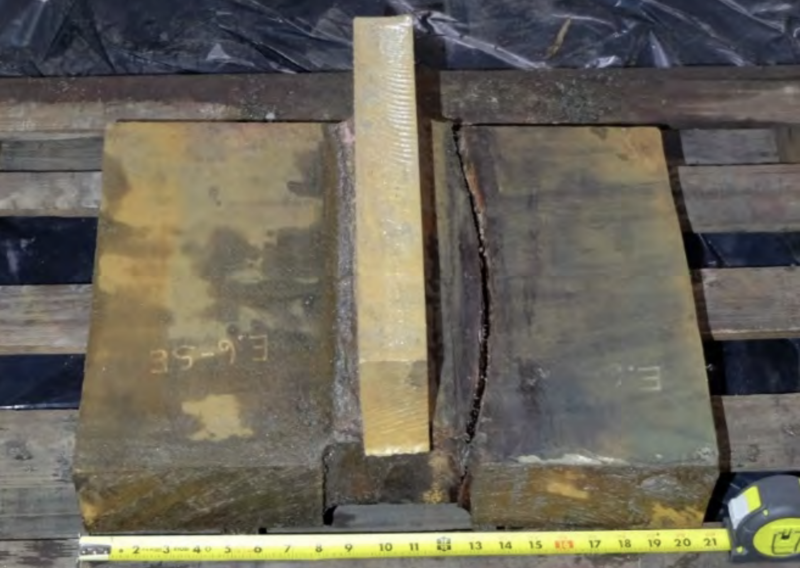The $2.2 billion bus terminal/park in the sky/train station of the future was shut down during the afternoon rush hour last Sept. 25 after workers discovered cracks in a pair of steel girders that help support the center’s bus deck where it crosses above Fremont Street.
At that point, the center had been open all of 44 days. Crews rushed to shore up the girders over Fremont Street. They installed similar bracing where the bus deck spans First Street just in case the structural steel there developed cracks. No cracks emerged in that second location, the one piece of good news that has emerged from this saga so far.
As of Monday, the transit center has been closed for 104 days -- more than twice as long as it was open.
So the question has occurred: When will the transit center reopen?
And the answer: No one knows for sure. Though in the 15 weeks since the center closed, the Transbay Joint Powers Authority, which oversees the facility, has been busy.
First, bracing the structure, because it would be unseemly to have the building fall down in the street. Then consulting with experts about how to go about investigating why the steel cracked. Then having laboratory tests conducted to zero in on the cause of the cracks. Then consulting with other experts about the best way to repair the girders. Then asking the first set of experts to sign off on the repair method recommended by the second set of experts. And then asking that first set of experts what other parts of the transit center might need to be inspected before the facility reopens.
And this is where things stand as we wait for the joint powers authority board to meet on Thursday:
The metal testing has been concluded. (The apparent cause of the fractures: Flaws introduced into the 40-inch steel girders by cutting torches used to make what have been called "access holes" for welding.)
Engineers have devised a fix -- it was shown when the board met on Dec. 13. An engineering peer-review panel convened by the Metropolitan Transportation Commission has approved the repair method. Officials with the authority have started the process of trying to procure the specialized steel needed for the repairs -- which will be done over both Fremont and First streets.
Christine Falvey, spokeswoman for the Transbay Joint Powers Authority, noted Monday that there is work happening at the transit center right now: Businesses that have taken out leases to open outlets there later this year are building out their spaces, for instance. And crews have been patching areas of the walkway through the rooftop park that had worn down during the six weeks the facility was open.
B
ut as to reopening?
The authority won't have a construction schedule until it knows when the steel for the repairs will arrive, Falvey said -- adding that it may have an answer about the steel within a week.
It's not clear how long the repair process itself, which will involve bolting massive steel plates to reinforce fractured or vulnerable areas of the girders, will take.
After repairs are completed, she said, the giant hydraulic gantries that have been supporting the structure's girders over Fremont and First streets will be removed.
"When that happens, the public will get to see some progress" toward reopening, Falvey said.
But that won't mean the doors will be thrown open right away. Before that happens, the MTC-appointed engineering panel must complete a study of other critical design elements in the transit center structure.
That review is happening at the insistence of several Transbay Joint Powers Authority board members -- notably Ed Reiskin, chief of the San Francisco Municipal Transportation Agency.
"We only learned of (the cracks) incidentally, because someone was doing some work and had the good sense to flag, that otherwise wouldn't have been seen or known," Reiskin said at last month's board meeting. "So I think what this board is seeking, and ultimately what the public will be seeking, is really a clean bill of health for the entire structure."
Michael Engelhardt, the University of Texas engineering professor who's heading the peer review team, told the meeting that his group will focus on four critical areas: heavy steel components which, like the cracked girders, may be prone to brittle fracture; the steel "hangers" that suspend the structure's massive bus deck; any damage that might be associated with the sudden failure of the cracked girders; and, "since we have buses rolling in and out of there," whether the facility's design has given adequate attention to the issue of structural fatigue.
Falvey said it may take until the joint powers authority board's February meeting before the peer-review panel reports back on how long its supplemental study will take.
We'll conclude here with what we think is a safe bet, with 358 days left in 2019: The transit center will reopen this year.
Until then, enjoy that big white art installation downtown.

